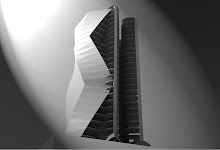A study on:
“Sustainable Architecture Module:
Introduction to Sustainable Design
by,
Jong-Jin-Kim and Brenda Rigdon”
Sustainable Design: Overview and proposal
In terms of sustainability, definitions of Growth and Progress need to be developed beyond the already set models. Existing concepts will soon stand at a vital crossroads. Either they can follow traditional models that focus only on GNP growth credited to capitalist consumerism or, create newer models to define ‘growth and progress’ on the basis of analysis that take into account entire economic life cycles.
Economic development often manifests itself through architecture. It is the driving force behind the built environment and with the increase of new buildings allows for examples in which the environment is either helped or harmed.
To identify these examples, and if negative, to prevent them from being repeated, architects must be educated in the principles of sustainable design. Architects must be presented with a multi-facetted conceptual framework comprising of three primary foci: principles, strategies and finally, methodologies.
Economic development often manifests itself through architecture. It is the driving force behind the built environment and with the increase of new buildings allows for examples in which the environment is either helped or harmed.
To identify these examples, and if negative, to prevent them from being repeated, architects must be educated in the principles of sustainable design. Architects must be presented with a multi-facetted conceptual framework comprising of three primary foci: principles, strategies and finally, methodologies.
The first Principle discusses the economizing of resources; curbing the use of nonrenewable ones. The second Principle details the difference between the life cycle of a sustainable building and that of a conventional one. Lastly, the third principle “Human Design” taps into the requirements of man, to determine how ‘livable’ a sustainable design space can be.
Every principle can then be divided into detailed sections that give way to strategies. These strategies provide detailed outlines, leading to methods for achieving sustainability. One such example of these sub-categories can be the ‘Post-Building Phase’ that falls under Principle 2: Life cycle Design. The Post-Building(1) Phase suggests materials be salvaged from buildings that have outlived their usefulness and be reused, in prospective projects.
The standards of humanitarianism coupled with those that promote environmental awareness form a schema, upon which a basic route for sustainability is encountered.
Through this study on sustainability and its already determined constituents, inferential outcomes extremely indicative of local sustainable design solutions can be reached.
A holistic review of the entire study can provide an overview, whereas attention towards details relevant to local energy conservation concerns can be used to route out localized issues, towards which, again, a dialectic study between generic and specific can lead to solutions.
Finding a solution that maintains the delicate balance of the ecosystem through designs sensitive to both living organisms and inorganic elements is sustainable architectures’ most sought after goal.
Citations:
(1). Sustainable Architecture Module: Introduction to Sustainable Design, Page 12, Principal 2: Life Cycle Design, Post-Building Phase
Every principle can then be divided into detailed sections that give way to strategies. These strategies provide detailed outlines, leading to methods for achieving sustainability. One such example of these sub-categories can be the ‘Post-Building Phase’ that falls under Principle 2: Life cycle Design. The Post-Building(1) Phase suggests materials be salvaged from buildings that have outlived their usefulness and be reused, in prospective projects.
The standards of humanitarianism coupled with those that promote environmental awareness form a schema, upon which a basic route for sustainability is encountered.
Through this study on sustainability and its already determined constituents, inferential outcomes extremely indicative of local sustainable design solutions can be reached.
A holistic review of the entire study can provide an overview, whereas attention towards details relevant to local energy conservation concerns can be used to route out localized issues, towards which, again, a dialectic study between generic and specific can lead to solutions.
Finding a solution that maintains the delicate balance of the ecosystem through designs sensitive to both living organisms and inorganic elements is sustainable architectures’ most sought after goal.
Citations:
(1). Sustainable Architecture Module: Introduction to Sustainable Design, Page 12, Principal 2: Life Cycle Design, Post-Building Phase


No comments:
Post a Comment